Ever since Carla Hollar pitched the idea of a Coen Brothers retrospective at the library to me—four critics, four movies—I’ve spent a lot of time in the company of the Coens’ movies. In fact, it’s fair to say that I’ve never had such a concentrated dose of the brothers. It’s been quite an experience—one that confirmed some things and brought new light to bear on others.
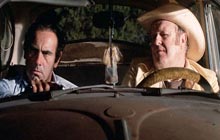
I’ve always had a strange relationship with the works of Joel and Ethan Coen. Though I was originally impressed with the cleverness (a key word when dealing with them) of their debut film, Blood Simple (1984), I wasn’t exactly sold on them. Their second film, Raising Arizona (1987), on the other hand, almost completely put me off them altogether. At the time of its appearance, a friend of mine commented, “The Coens sure know how to throw a camera around, but so what?” That pretty neatly summed up my feelings. So what? I didn’t respond to the events, didn’t like the characters and related to none of it. In all honesty, I still don’t.
As a result, I was completely uninterested when Miller’s Crossing (1990) showed up. I bumped into it totally by accident on a premium channel a year later and wasn’t even paying much attention to it. It was just something to break the silence that didn’t annoy me. Then, as I’ve confessed elsewhere, it came to the “Danny Boy” scene where a couple of gangsters show up to try to kill Albert Finney. Something about that caught my attention. By the time the scene was over, I was hooked and watched the rest of the film—with plans to see it from the beginning the next time it aired. I did and my view of the Coens did a quick 180 degree turn.
This often violent, often quirkily funny, ultimately strangely moving gangster yarn (which steals unabashedly from Dashiell Hammett’s The Glass Key and to a lesser extent his Red Harvest) not only lived up to the promise of Blood Simple, it went way beyond that promise. It offered—as the best of the Coens’ work invariably does—solidly defined characters delivering impossibly clever and witty dialogue that could never exist outside the confines of a movie. The amazing thing about this utterly stylized badinage is that it’s perfectly realistic within the confines of the movie itself. No, people don’t actually talk like this, but they do in Miller’s Crossing, which exists in its own self-contained world.
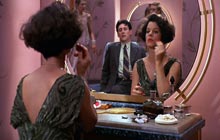
I think they key to all this lies in the fact that the Coens are movie generation baby boomers. Joel was born in 1954 and Ethan in 1957, making them prime candidates for a childhood fueled by old movies on television. There’s even a good chance—at least some of the original paintings by James Whale used in Bill Condon’s Gods and Monsters were borrowed from Joel’s personal collection—they were “monster kids,” but of the type whose interests soon branched out into a larger realm of film. Evocations—some direct, some more vaguely suggested—of all types of movies run throughout their filmography. Theirs is a set of movies that is deeply infused with a love of other people’s movies—though filtered through a sensibility that is purely their own.
In the case of Miller’s Crossing the Coens give us a very movie movie. It could only be a movie and it makes no pretense of being realistic in any strict sense of the word. Yet apart from the plot aspects that are purely out of The Glass Key (and possibly from either the 1935 or 1942 film version), and the small town gang warfare business from Red Harvest, I’d be hard-pressed to make any specific connection to any pre-existing film—with the wholly reasonable exception of Blood Simple.
Much the same is true of their next film, the even more self-contained Barton Fink (1991), which is perhaps the most densely layered and disturbing film they’ve yet made. (It was a hard call whether to choose this or Miller’s Crossing as my choice of Coen film to run for the library series. Miller’s Crossing edged it it out, but only just.) As with Miller’s Crossing the movie’s a period piece, but rather than draw on any literary models as such, it draws on aspects of literary and Hollywood history. (There’s also a hangover from Red Harvest concerning the still shocking murder of one of the characters.)
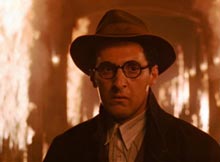
Barton Fink presents its title character (played by John Turturro) as a thinly-veiled version of Clifford Odets (he even looks like Odets)—and it’s not a terribly flattering picture of the writer. Fink, like so many playwrights and novelists of the time, is lured to Hollywood to write screenplays—lured, it must be added, by studio bosses who have no idea what he writes; they only know he’s currently a hot item on the New York theatre scene. Since Fink fancies himself as a representative of the “common man,” he takes a room in a run-down flea bag of a hotel with a dead fern in the lobby and seemingly one employee, the bellhop Chet (Steve Buscemi), and one guest, a traveling salesman (he says) named Charlie Meadows (John Goodman).
The atmosphere of the hotel is decidedly sinister—somewhere on the border between gone-to-seed decay and outright evil. The wallpaper in Fink’s room is prone to peeling from the heat. His next door neighbor, Charlie, is prone to bizarre crying jags that can be heard through the wall. Later Charlie becomes a frequent caller—an apparent example of Fink’s beloved “common man.” The irony is that Fink never recognizes this and whenever he might be about to get an insight into the real common man, he always interrupts Charlie with some high-falutin rant of his own about modern theatre.
Life is no better at the studio. Though he’s surrounded by sycophants, Fink’s supposed talents are channeled into writing a Wallace Beery B picture about wrestling, a topic about which he knows nothing (“What’s to know? It’s about big men—in tights”). Almost immediately, Fink is stricken with writer’s block—stuck on an opening that’s obviously cribbed from his big stage success. Soon he’s hallucinating to the point where he even finds the opening of his stalled screenplay in the Bible. (It’s hard to imagine a more pointed comment on the ego of the main character than this.)
Complicating matters, Fink discovers that one of his great literary heroes—an equally thinly-veiled version of William Faulkner—W.P. Mayhew (John Mahoney) is also “working” at the studio. What he actually learns is that Mayhew is a hopeless alcoholic, whose mistress, Audrey (Judy Davis), does most (maybe all) of what writing gets done—at least, in between bouts of being beaten up by Mayhew. The world that Fink thinks he knows becomes ever more tenuous as the film charts his decline.
The real question posed by the film is whether or not there really is a decline, or merely Fink’s slow recognition of his own shortcomings. When the film was still relatively fresh, I had an argument with a friend who found Barton Fink to be a great movie about the process of writing. I countered his viewpoint by saying that, no, David Cronenberg’s Naked Lunch, which came out later the same year was that, but that ultimately Barton Fink was about an ivory-tower poser who is more self-delusional fake than actual writer. In many ways, the film itself is a slap at cozy middle-class armchair radicals.
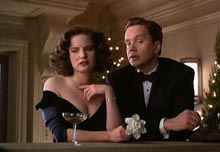
As if to take a break from the nightmarish world of Barton Fink, the Coens’ next project, The Hudsucker Proxy (1994), was a take on the social comedies of Frank Capra, specifically evoking Mr. Deeds Goes to Town (1936)—with a fair amount of Preston Sturges, dash of Howard Hawks and a dollop of Terry Gilliam’s Brazil (1985) thrown in. The latter may seem a stretch to some folks, but anyone who can honestly watch the mailroom scenes in Hudsucker and not see evocations of Brazil isn’t looking very hard. The strange thing is that while there’s no denying that the film is lighter in tone than Barton Fink, it also has a slightly nightmarish feel to it—something that probably explains why it didn’t resonate any too well with either the fans or the critics.
This period (1959) yarn about a Preston Sturges-like example of the “boobus Americanus” or “sucker sapien,” who’s set up as the fall-guy for a corporate take-over, and accidentally becomes (albeit briefly—at first) a tyro of industry by inventing the Hula-Hoop (“You know, for kids”), frankly baffled audiences. And there’s no denying that for a comedy, it’s a strange movie. Actually, it’s a strange movie in any genre, but it’s a movie that has worn well in the intervening years when revisited. It’s certainly imperfect—some of the earlier scenes in particular are ridiculously broad, especially as concerns the performances of Tim Robbins and the impossibly mannered Jennifer Jason Leigh, who tries too hard to channel Katharine Hepburn (mindless of the fact that she ought to be channeling Rosalind Russell or Jean Arthur). But even its imperfections are rarely less than fascinating.
There’s a boldness at work in Hudsucker that’s hard not to admire. Perhaps no film in the Coens’ oeuvre is so brazen in its tonal shifts, and certainly none is as wild in its plotting—or at least that’s true up until O Brother, Where Art Thou? in 2000. In fact, that later film makes a good companion piece to Hudsucker. The two have a similar tone of voice in the realm of off-hand fantastication, and both—with the exception of their one outright remake, The Ladykillers (2004), for diferent reasons—are the films of theirs that deliberately evoke specific movies other than their own.
A major success lay just two years away with Fargo (1996), which is a movie on which I part company from even the mainstream of Coen fans. It may simply be a case of too much build-up, but my personal response to the film was that it was fine, but I didn’t see what all the fuss was about. All in all, I still don’t, though I really need to watch it again. Still, I am hard-pressed to imagine that this film about a botched crime (a persistent theme in the Coens’ films) is ever going to edge out my favorite Coen Brothers movies. It’s not a bad movie—far from it—but it somehow never really connects with me. I’m willing to admit that the fault may be mine and that someday I can better appreciate it in the overall context of their work.
I have a similar problem with their next picture, The Big Lebowski (1998), though at least with it I can understand what all the cult-based fuss is about. And I do admire the film’s satire on the Raymond Chandler school of crime fiction (one gets the feeling that the Coens take Dashiell Hammett rather more seriously) and its bowling alley vision of a Busby Berkeley musical number. Nonetheless, it’s a film that seems a minor work to me, and one that comes under the heading of “more clever than good.”
At the same time, I admit that part of my problem with the film stems from purely personal reasons, which have nothing to do with the film itself. A few years ago, there was a guy living with me who would watch The Big Lebowski two or three times a day. When he wasn’t watching it, he was doing his impression of Jeff Bridges as the Dude. To say that I was quickly Lebowskied out would be an understatement. Having said that, however, I didn’t like it very much before that unfortunate experience, which may or may not have something to do with an idea put forth to me recently by someone, who suggested that it’s a movie that works better if you’ve lived in L.A. and have a west coast sensibility—neither of which is true of me.
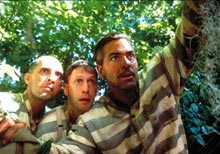
However, the Coens returned in 2000 with a film that I think is not only in the top three films of their career, but is simply a great American film in general, O Brother, Where Art Thou?. It was interesting to see that Touchstone Pictures had very little faith in this film when is came out. That was back when presskits were still elaborate affairs, packed with production information and a large selection of 8” X 10” stills for newspaper and magazine use. The presskit I received for O Brother consisted of a small booklet and one 5” X 7” photo. Moreover, the movie was booked into a single theater locally—where it played so long that the poster looked like it would crumble when it finally left.
One of the most striking things about O Brother is its inspiration. The film’s storyline itself is a version of Homer’s The Odyssey, but its actual genesis is Preston Sturges’ Sullivan’s Travels (1941). Sullivan’s Travels tells the story of a filmmaker, John L. Sullivan (Joel McCrea), who is known for making popular comedies and musicals, but who wants to break free from these frothy concoctions to make a movie “that will mean something.” The movie he wants to make is called O Brother, Where Art Thou?. The Coens’ film is an imagining of what that movie might have been. At the same time, it manages to follow something of the structure of Sullivan’s Travels and incorporates details from it—as well as evocations of The Wizard of Oz (1939), Mervyn Leroy’s I Am a Fugitive from a Chain Gang (1932) and Arthur Penn’s Bonnie and Clyde (1967). (In fairness, it should be noted that Sturges has already borrowed from Chain Gang in his film.)
While O Brother wears its sources out in the open, it’s yet another example of how all of this material is filtered through the Coen’s own particular sensibility, so that it’s never anything but its own film—or maybe I should say its own Coen Brothers film. In some ways, it’s an extension of their fascination with stories of crimes gone wrong, since O Brother could be said to be about a jail (or chain gang) break gone wrong. Moreover, its three heroes—George Clooney, John Turturro, Tim Blake Nelson—are all victims of crimes (some rather silly) gone wrong, which is why they’re in this situation in the first place.
Perhaps its strongest connection to the past lies in its peculiar reverence for words. While the dialogue in virtually all of the Coens’ works is witty and literate, the debt here to Preston Sturges and his style of dialogue is inescapable. The interesting thing is that it was always there, but it only became evident after O Brother, where it’s more obvious than in any of the other films with the possible exception of their later film, The Ladykillers. Go back and listen to the music of the words in their earlier films and you’ll see what I mean—especially, if you’re familiar with Sturges’ screenplays.

Their next film, The Man Who Wasn’t There (2001), is one of their oddest works—and probably is still their least known. It’s really the film where the Coens went all-out noir—even to making the picture in stunning black and white, which may not have been in its favor commercially. However, in all honesty, the film is so peculiar—we’re talking awfully close to David Lynch peculiar here—that the choice of format was probably immaterial.
In essence, the film is the fairly typical Coen material in that it deals with a crime (partly brought about by a scheme that isn’t too far afield the one that drives W.C. Fields’ The Bank Dick (1940)) that goes wrong, but Billy Bob Thornton’s character, Ed Crane, is something else again. At the time the film came out, I wrote, “There’s also some question about whether or not it’s really possible to latch onto a character as completely disaffected as Billy Bob Thornton’s seemingly emotionless barber. And there’s no denying that it is hard to connect with the character, but then again, identification was never a mainstay with the genre. The Coens have merely taken that one step further—and then they subvert that by suggesting that the character is a lot more human than he appears on the surface, more so than he realizes himself.” Early Coen protagonists hadn’t always been exactly cozy, but they’d been recognizably human. That’s not so obvious in the case of Ed Crane.
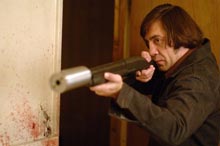
The film itself has a similarly disaffected feeling to it—a coldness, a kind of take-it-or-leave it atmosphere that isn’t altered by the film’s sometimes bizarre flights of fancy. It’s the kind of movie that’s easier to admire than to like. In fact, it’s a film I haven’t seen since it came out and one I don’t think about very often when I think of the Coens. I think it might be time to revisit it, since I have half a hunch that it’s a film that may benefit in retrospect, and in light of No Country for Old Men (2007), which is the closest film to it in tone that they’ve made.
Intolerable Cruelty (2003) is the closest thing to a “normal” movie ever to come from the Coen Brothers. It is to their filmography something like Planet of the Apes (2001) is to that of Tim Burton, which is to say that your response to it is likely to be along the lines of, “OK, so you’ve proved you can make a mainstream film—don’t do it again.” It’s so much more satisfying when the mainstream meets you at least half-way. At the same time, it’s not a bad movie. It’s entertaining on its own black romantic comedy terms, and it boasts a number of very clever touches. Still, it’s the one Coen Brothers film that could be called inessential.
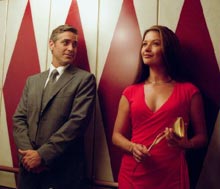
Far better, though insufficiently appreciated is their rethinking of Alexander Mackendrick’s 1955 Ealing comedy The Ladykillers. I’ve never understood the ire with which some people greeted this film—except, of course, for its status as a remake. Worse, it’s a remake of a classic. My own response to all this is a huge, “So?” The 1955 film is still there. We aren’t living in the days Louis B. Mayer when a remake meant the original would be shut away to prevent comparison. Personally, I own both versions and love both—often for very different reasons.
Without getting into an in-depth comparison of the two films, it’s worth noting that the Coens transferred their take from London to a pocket of the U.S. south—a kind of separate world where aspects of the Old South sit side-by-side (not always comfortably) with the modern world. It’s a world that perfectly captures the essence of a small southern town—one where odd behavior is accepted as personal eccentricity. Tom Hanks’ Prof. G.H. Dorr—with his old southern gentleman attire—would be conspicuous anywhere, but he’d be less improbable in this setting. The dottiness of Irma P. Hall’s Marva Munson is also of the kind that’s acceptable on an “Oh, that’s just Mrs. Munson!” level in this realm.
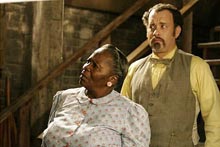
There’s one other truly significant change. The original Professor (Alec Guinness) is a much more sinister figure. There are, in fact, hints that he may be actually insane. (Any suggestion of insanity will send him into a murderous fury.) Hanks’ Professor is much more a strangely charming eccentric. He’s more a poser who tries to present himself as a scholarly gentleman of the old school with more education (“I’ll handle this as only one with a classical education can”) than he probably has. He’s every inch a humbug, but there’s an undercurrent of sadness to him. As written by the Coens and played by Hanks, Prof. Dorr is as much posing and posturing to convince himself of his brilliance and erudition as anybody else. This is who he wishes he was. It’s significant that it’s this bid for slightly pompous intellectualism that finally seals his fate.
The Ladykillers is a bit on the imperfect side. The Marlon Wayans character often seems to have wandered in from a different movie—though this works well in contrast to the scene where his toughness falls apart. There are moments when the film gets perilously close to derailing, but never quite does. And all the scenes between Hanks and Hall make up for anything that’s not quite right. Beautiful design, flawless cinematic technique, a terrific spiritual/gospel soundtrack and even (God save us) a wonderful use of CGI take up the rest of the slack. Regardless, it’s very hard no to love a movie where a criminal mastermind sits down in a greasy-spoon restaurant with confederates and informs the startled waitress, “We must all have waffles. We must have waffles forthwith!”
That brings us up to the Coens’ big triumph with the Oscar-laden No Country for Old Men (2007)—a film that’s almost as good as its awards, and gets extra points for getting them without concessions to the mainstream. What could have been transformed into a very good, but somewhat ordinary thriller is transformed into something like pure gold by a refusal to go with an easy ending that spelled everything out for the viewer. It’s not that the ending of No Country is ambiguous—especially, if you’ve been paying attention, and even more if you’ve been paying attention to Tess Harper’s character—it’s that the film leaves it to the viewer to understand what’s been said and what it means.
Now, we find ourselves looking toward their latest, Burn After Reading, which opens this fall. And thank God, it does because there’s not all that much—so far—on the horizon that looks all that promising for this year’s “awards season” when the studios traditionally put out their “prestige” pictures. With something from the Coens in the offing, the future looks a good deal brighter. But then that’s something the Coens have been doing for the movies for 24 years now. When you consider that most great filmmakers (yes, there are exceptions) have a period of five to ten years of works that stand out as their richest period, that’s something of a miracle.
The Coen Brothers Go to the Library
Spend a month of Saturdays at Pack Memorial Library awash in the cinematic offerings of Joel and Ethan Coen as four movie critics—Peter Loewer, Ken Hanke, Marcianne Miller and Justin Souther—each show his or her favorite of the Coens’ films. The series starts Saturday, Aug. 16, at 2 p.m. with a panel discussion by the opinionated four (where the library’s Carla Hollar will put forth some hard questions). The discussion will be followed by Peter Loewer’s screening of the Coens’ first film, Blood Simple, followed by a Q&A with Loewer.
Subsequent screenings will be Miller’s Crossing (1990) (Ken Hanke) on Aug. 23, The Big Lebowski (1998) (Marcianne Miller) on Aug. 30 and O Brother, Where Art Thou? (2000) (Justin Souther) on Sept. 6. All shows start at 2 p.m. and are free. For more on the Coen Brothers check out this Friday’s “Screening Room” by Ken Hanke on the Mountain Xpress Web site




Wanted to add that today’s panel discussion and screening of Blood Simple was one of the best attended — possibly the best attended — film events I’ve ever seen at the library. The panel discussion was rather fun (and I was only sort of joking when I said the Coens should remake The Seventh Seal) and no blood was shed, though the gauntlet was thrown down when both Marcianne and Peter expressed a dislike for Barton Fink. If we ever do a follow-up set of Coens, I have vowed to subject them to that title.
A word of advice — in my experience, attendance for these library series tends to increase with each film shown, so I’d suggest getting there a few minutes early to ensure a good seat.
I’ve never heard of these Coen Brothers. They sound interesting.
I’ve never heard of these Coen Brothers. They sound interesting.
Well, they’re kind of new, but keep your eye on them. I’m betting we’ll be hearing more from them — and I don’t mean a postcard.
I was happy to see that you think “O Brother” is a “great American film”. I do but haven’t found that many other people who do. They seem to think it’s too entertaining to be taken seriously.
I was happy to see that you think “O Brother” is a “great American film”. I do but haven’t found that many other people who do. They seem to think it’s too entertaining to be taken seriously.
Oh, dear, the art-as-nasty-medicine school of criticism, eh? I’ve never understood that and certainly never subscribed to it. Indeed, it’s a line of thought that makes me appreciate the “I-don’t-understand-it-so-it-must-be-art” school. At least that offers room for amusement.
Mr. Hanke, sir, I have lost all respect for your opinions. No longer will I look to you for any movie advice, ever.
How dare you denigrate the comedic genius of Raising Arizona with such a throw-away comment like so what?!?
If duels were legal, I’d challenge you.
[Please duly note the intended jest of above comment. Mostly.]
Well, I’ve been wondering when someone would take issue with this! All it took at the library was me mentioning that I’m not wild about Raising Arizona to provoke someone to yell out, “Traitor!” (I’ve yet to quite figure out the charge in this context, but it got a terrific laugh.)
If you really insist on a duel, we could always go with tiddly-winks — loser has to sit through The House Bunny…twice.
I’m with you, Ken…not a fan of “Raising Arizona” either. Let me know if you need a second for the duel.
loser has to sit through The House Bunny…twice.
I’ll see your House Bunny (not literally, God no), and raise you two screenings of Disaster Movie.
Honestly, I’ve never met anyone who didn’t at least like Raising Arizona. Old people, pffft.
Let me know if you need a second for the duel.
I may take you up on that. At the very least, you can hold my coat and call the ambulance.
I’ll see your House Bunny (not literally, God no), and raise you two screenings of Disaster Movie.
The sad part is that I actually will see these things, though two screenings seems unlikely to an extreme degree.
Honestly, I’ve never met anyone who didn’t at least like Raising Arizona.
I’ve known a few, but we’re a rare breed, it’s true.
Old people, pffft.
Mind what you say or I’ll give you a thump with my cane.
The sad part is that I actually will see these things
I’ll believe it when I see it. Or not see it, I guess. Whatever makes more sense in this instance.
I’ll believe it when I see it. Or not see it, I guess. Whatever makes more sense in this instance.
Hey, I promised that I would sit through those two films. You have no faith.
You don’t mention another Coen “classic” — Fargo.
Yes, it’s mentioned, just not in depth.